
Erik Swietlicki
Professor

Urban air pollution source apportionment using a combination of aerosol and gas monitoring techniques
Författare
Summary, in English
The dominating local and regional sources of gaseous and particulate air pollution in the city of Lund (69,000 inhabitants) in southern Sweden were characterized using a combination of aerosol and gas-phase monitoring techniques. Twelve-hour samples were taken at two stations of both fine and coarse fraction urban aerosols with a stacked filter unit during the four-week measurement campaign in March/April 1993. The aerosol samples were analysed with PIXE for 14 major and trace elements. In addition, gaseous species (SO2, NO2, O-3) were measured simultaneously with the DOAS technique over two stretches, crossing each other only 300 m from the downtown aerosol sampling site. The combined results obtained by the analytical techniques PIXE and DOAS for aerosol and gas measurements, respectively, were used in an absolute receptor model in order to identify the major sources affecting the measurement sites and to apportion the measured air pollutants to the identified sources. The gases (SO2, NO2, O-3) could also be attributed to specific sources by combining the trace elemental concentration data for the fine fraction aerosol with that of the gaseous species in the receptor model. According to the absolute principal component analysis (APCA) model, the dominant sources for the measured species were resuspended road dust, automobile and diesel emissions, combustion of oil and coal, ferrous and non-ferrous smelters and sea spray. Of these, the sources related to traffic are mainly local in character while the others constitute a regional background. For a small city in southern Scandinavia like Lund with only light industry, the long-range transported air pollutants make up a significant part of the fine fraction aerosol. (C) 1996 Elsevier Science Ltd
Avdelning/ar
- Fysiska institutionen
- Atomfysik
Publiceringsår
1996
Språk
Engelska
Sidor
2795-2809
Publikation/Tidskrift/Serie
Atmospheric Environment
Volym
30
Issue
15
Fulltext
Dokumenttyp
Artikel i tidskrift
Förlag
Elsevier
Ämne
- Meteorology and Atmospheric Sciences
Status
Published
ISBN/ISSN/Övrigt
- ISSN: 1352-2310